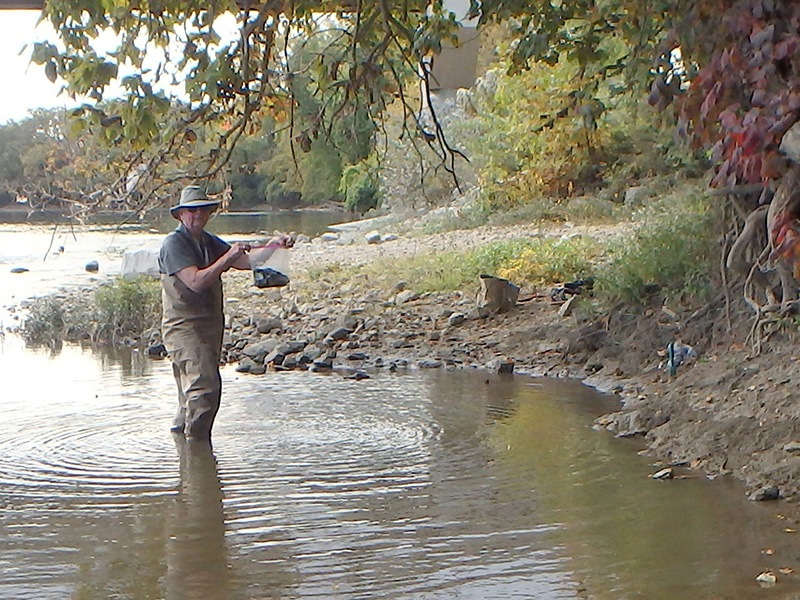After sampling the Scioto River and studying its changes in water quality for as far back as the 1970s, macroinvertebrate ecologist Jack Freda and field technician Ashley Smith were used to seeing signs of improvement and encountering new species, but what they found just a short distance from downtown Columbus was an unexpected surprise. While collecting macroinvertebrates near the I-270 South Outerbelt, Ashley noticed some old mussel shells, weathered white with age and poking out of the silty muck at the base of a four foot clay bank (Figure 1).
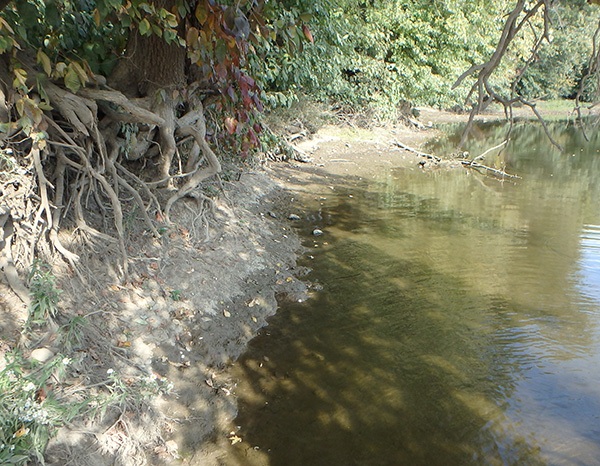
Figure 1. The exposed clay bank along the Scioto River downstream from Columbus where mussel shells were initially found.
At first, this wasn’t considered surprising since it’s not uncommon to find long-dead, weathered shells, or even live specimens, along historically degraded sections of the Scioto. However, it quickly became apparent these specimens were very different from the shells that are normally encountered. For one, they included the rare but distinct and aptly named, “rabbitsfoot” mussel which is now restricted to only a handful of high quality streams in Ohio, such as Little Darby Creek. In addition, numerous “Pleurobema-type” shells were found with their protruding and strongly deflected shell beak or “umbo” at the hinge point. There are a number of different species within this genus but most from Ohio are rare and state-listed by the Ohio Department of Natural Resources and some are even federally-listed (Figure 2). As sampling continued, they realized the shells were not only accumulating at the base of the bank, but were also buried and protruding from the soft clay near the waterline (Figure 3). Within a half hour, dozens of shells were excavated, many of which were in remarkably good condition. For example, most retained their periostracum, the thin, outer organic layer or “skin” that gives the shells their color and distinctive patterns. Others had unworn bumps and pustules and a few still retained their delicate inner shell lining or “nacre”. Later, after MBI mussel specialist Anthony Sasson joined the sampling, more shells were found, not only in the clay, but in additional deposits further from the bank. These were covered by a layer of muck and silt and perched on the shallow, hardpan shelf that extended out into the channel.
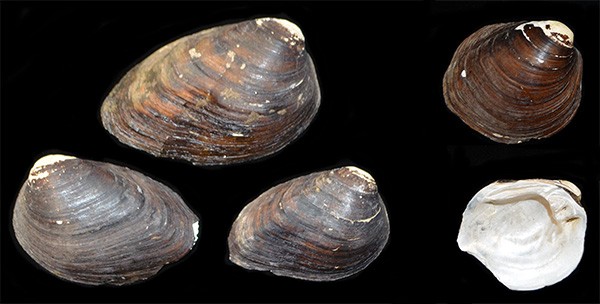
Figure 2. Specimens from the site included 130 whole or half shells of the federally endangered clubshell mussel (Pluerobema clava; left) and rough pigtoe (Pleurobema plenum; right), a species extirpated from Ohio.
At first glance, it was thought the shells might represent an old muskrat midden or a “garbage dump” of spent shells where, over time, muskrats or raccoons pried apart, ate, and then discarded the empty shells of their prey. However, midden specimens usually show evidence of gnawing, like teeth marks or claw scratches, and these specimens had none. It seems more likely the shells were dead, possibly the result of a die-off, then deposited soon after by high water or a flood. One thing was obvious, the shells did not represent recent populations and must have been living before this section of the river became grossly polluted, a period of between 140-180 years ago.
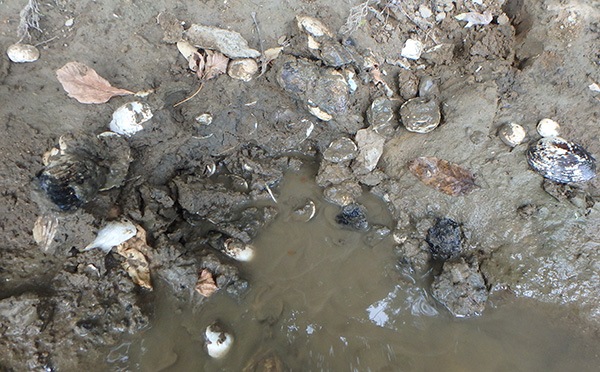
Figure 3. A large deposit of exposed shells embedded in the Scioto River clay bank.
After the shells were returned to the MBI lab (Figure 4), they were cleaned, initially sorted, then tentatively identified by Anthony, Jack, and another MBI taxonomic expert, Mike Bolton. Since then, mussel experts from the Ohio State University Museum of Biological Diversity and other environmental firms have examined the shells and assisted with identifications. At this point, and from this very small site, a tentative accounting has identified 21 different species including 16 that are currently state-listed species or concern, state threatened, state extirpated, federally endangered, or extinct (Table 1). The extinct species is the tubercled blossom pearly mussel (Epioblasma torulosa torulosa), a close relative of the rare, northern riffleshell (Epioblasma torulosa rangiana).
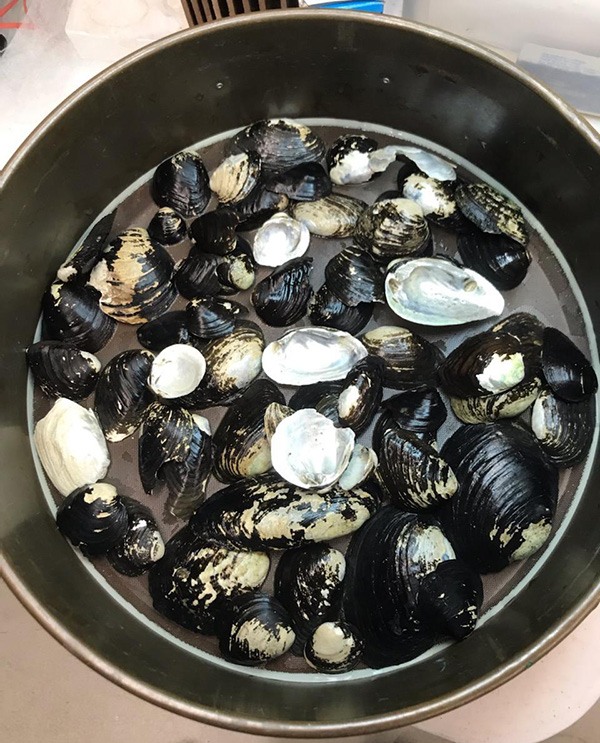
Figure 4. Back at the MBI lab, a small portion of cleaned shells from the Scioto River collection. Over 350 shell halves were removed, representing 21 tentatively identified species.
The Scioto River first received sewage discharges in 1841 when Columbus constructed the first sewer to discharge into the Scioto River and which expanded as the population increased through the 19th century (Historica Milestones for Wastewater Treatment in Columbus).
The diversity of shells from this one isolated spot along the Scioto River was stunning to say the least. By comparison, the 21 species from the river bank represent nearly half (48%) of the number of species recorded in the entire Big Darby Creek watershed (44). According to the Darby Creek Association website, the Darby has been described as having “for its size, the greatest diversity of freshwater mussels in North America" (Watters, 1994). Within Franklin County, 26 live or freshly dead species have been found in the 30-mile stretch of the Scioto River mainstem since 1980. While the number is encouraging, none of the most sensitive, federally endangered species recorded from the Scioto prior to 1980, or from the “ancient” river bank collection, are included.
Besides the remarkable diversity of the shell collection and their surprising condition, the find also has potential historic or ecological value. Given the history of Columbus’ founding and the subsequently severe water quality degradation that characterized the river throughout the nineteenth century, the shells are likely not of recent origin. Whether the spent shells accumulated naturally over time, were indicative of “a” die-off, or represent “the” die-off (i.e., the point where conditions below Columbus became so polluted that populations were wiped out) is interesting to speculate. To help find an answer to that question, MBI is currently in contact with radiocarbon experts to try to date the shells and hopefully learn their age with more accuracy. Regardless of the exact timing, the shells still provide a rare, and fairly accurate glimpse into what populations and conditions were like in Central Ohio before many of its streams and rivers were seriously polluted. In addition to records and specimens like those at the Ohio State University Museum of Biological Diversity, this information also helps create a more reliable and empirical baseline record of pre-settlement conditions in Ohio. While it is not yet possible to “recreate” or recover our streams and rivers to such a state, the data provide a scale to help measure the true scope of environmental change in central Ohio over time and better define the “costs” that were paid for our current development and “modern civilization”.
Table 1. Twenty one tentatively identified mussel species from the Scioto River “ancient mussel” site in southern Franklin County, 2022.
| Scientific Name | Common Name | Status (2022) |
| Alasmidonta marginata | Elktoe | Ohio Species of Concern |
| Amblema plicata | Threeridge | |
| Cyclonaias tuberculata | Purple wartyback | Ohio Species of Concern |
| Elliptio crassidens | Elephant-ear | Ohio Endangered (OE) |
| Epioblasma torulosa1 | Tubercled blossom | Extinct |
| Epioblasma triquetra | Snuffbox | Federal Endangered (FE), OE |
| Eurynia dilatata | Spike | |
| Fusconaia flava | Wabash pigtoe | |
| Fusconaia subrotunda | Longsolid | OE |
| Lampsilis cardium | Plain pocketbook | |
| Lampsilis fasciola | Wavy-rayed lampmussel | Ohio Species of Concern |
| Ligumia recta | Black sandshell | Ohio Species of Concern |
| Obovaria subrotunda | Round hickorynut | Ohio Threatened (OT) |
| Ortmanniana (Actinonaias) ligamentina | Mucket | |
| Pleurobema clava | Clubshell | FE, OE |
| Pleurobema plenum | Rough pigtoe | FE, Ohio Extirpated |
| Pleurobema sintoxia | Round pigtoe | Ohio Species of Concern |
| Ptychobranchus fascolaris | Kidneyshell | Ohio Species of Concern |
| Theliderma (Quadrula) cylindrica | Rabbitsfoot | Federal Threatened, OE |
| Truncilla truncata | Deertoe | Ohio Species of Concern |
| Cambarunio iris | Rainbow | Ohio Species of Concern |
Identification needs to be confirmed.
Editor’s Note: MBI would like to acknowledge the assistance of Tom Appel, Plant Manager of the Columbus Limestone, Shelly Material quarry for providing access to the river through their property.

